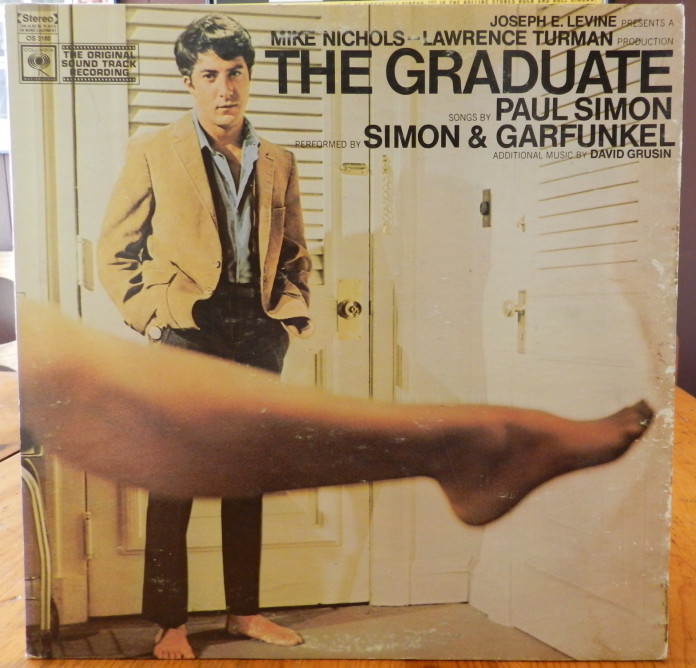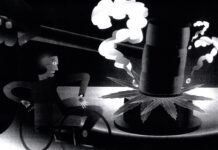
The Graduate’s anti-hero would find himself in serious trouble with Politically Correct campus orthodoxy in 2016, where a character so white would have to be wrong
[First published here in March 2016, I had a feeling it was prescient. I’d like to say it’s fun to be right, but…]
By Mark Cromer
As hundreds of students at the elite, leafy cloister that are the Claremont Colleges in Southern California excitedly poured over a vast array of vintage albums offered at a record show one recent weekend, their youthful enthusiasm for vinyl provided a measure of assurance that some things are indeed eternally cool.
But as I pulled the original motion picture soundtrack for The Graduate out of a stack and marveled at the enduring power of its iconic cover shot—that freeze-frame of a disheveled Dustin Hoffman gazing somewhat hypnotically at the sublime promise beheld in Anne Bancroft’s invitingly outstretched leg—I was again reminded just how much has changed on American college campuses.
The film that once was synonymous with all the nuanced casual cool of the changing of the generational guard is now seen by the twin towers of academia and Hollywood less as a timeless cinematic masterpiece and more as a troubling postcard from the past that begs rectification.
When Mike Nichols’ film adaptation of Charles Webb’s novel hit American theater screens in December 1967, it was as potent a clarion of the seismic cultural upheaval sweeping the country and the Western world as The Beatles Sgt. Pepper had been just six months earlier.
Hoffman’s portrayal of the confused and restless Benjamin Braddock, who’d just left the comfortable womb of college determined to live a life that was “different,” resonated with most everyone under thirty nearly a half-century ago. Yet by the standard of ideological orthodoxy rigorously applied on campuses today, Braddock would be seen as absolutely heretical to the sacred truisms that are now chanted in unison by students, usually with their clenched-fists raised in what appear to be crowd-sourced loyalty oaths of the 21st Century. And in that cauldron of multicolored sameness, a white and uncertain Braddock is a poster-child for what Boston University’s Saida Grundy declared to be “a problem population.”
With understated mannerisms delivered in a deadpan efficiency that reflected the deep ambivalence with which he viewed a future that seemed to offer little more fulfillment than—in just one word: “plastics”—his mixed feelings about the world around him were understandable even as the gravitational pull of Braddock’s lineage was never in question. Braddock was a Pasadena WASP that was raised as the center of a one-child, nuclear family universe, and he led a life that was marked by a pool in the backyard and an Alfa Romeo in the driveway. It was a gauzy cocoon of gin and tonic evenings, of afternoons sailing out of Newport Beach and of runs up PCH for Morro Bay getaways when the clamor of the cocktail shakers grew too loud. While the shimmering lanterns that hung across the patios of Anglo suburbia that stretched across the foothills from Claremont to Malibu did not possess the allure (yet) for Braddock that it did for his parents, nor did the light they cast on his inheritance torture him with the idea that it was all somehow fraudulently obtained.
Viewed now through the cultural prism (or rifle scope) of political correctness that prevails on today’s college campuses, Braddock’s most grievous sin would be his unawareness that his reality, his world, indeed, his very existence is, well, problematic.
Hoffman’s Braddock drifts through scene after scene of a white world visibly disturbed only over his place in it, but seemingly at ease—indeed, guilt free—by the utter absence of ‘peoples of color’ in his surroundings. His being undisturbed by the very whiteness of his world would be Exhibit A in the Camus-like show trial Braddock could look forward to on campus today. Succored by an establishment media that reflects and reinforces an obsession with how white virtually anything is today—and by that measure determining its value and legitimacy, with the less white it is the more valuable to society it is deemed to be—many college students today appear more inclined to view Braddock as a malignant personification of a creeping shadow of oppressive whiteness. His effective shrug at the alleged travails of self-declared ‘marginalized students’ would be enough of a trigger to fix Mizzou’s Melissa Click’s face into that now familiar portrait of rage and to get her screaming again that she “needed some muscle” to remove Braddock from campus.
Beyond his basic existence, Braddock’s actual actions depicted in the movie would also require campus-wide condemnation today.
In 1967, sleeping with the wife of his dad’s business partner was the epitome of salacious dysfunction and a Peyton Place scandal, while falling in love with their daughter and refusing to take ‘goodbye’ for an answer was seen as admirable romantic tenacity. But in 2016, it is Braddock’s initial reluctance to sleep with Mrs. Robinson that would be considered the scandal and his tortured longing for Elaine that would be viewed as possessive delusion sliding into psychotic criminality.
The images of a solitary Ben Braddock sitting in his darkened bedroom at his parent’s house writing the name ‘Elaine’ over and over again on piece of paper, of parking down the street from the Robinson’s home so he could catch glimpses of her, of then following her up to Berkeley and renting a room on Carter Street and sitting-in on classes just so he could be near her as he pondered his options—all of that and more would serve as the material facts underpinning a searing indictment unsealed in the court of campus politics. Benjamin Braddock: Stalker.
If Braddock were to arrive in Berkeley today, he would find those mercurial “outside agitators” that Mr. McCleery was worried were using his boarding house as a base of operations in 1967 are now on faculty at Cal and they would likely be far less “congenial” about his auditing their courses. In 1967, Braddock’s hesitation to come clean with Elaine about his affair with her mother was a matter of exercising thorny discretion while standing in the middle of a minefield of his own-making, something that would today constitute deception-by-omission and call into question whether Elaine had actually consented to even making out with him.
After all, how could Elaine Robinson, a semi-marginalized student by today’s campus measure (white-but-female) legitimately consent to arriving at proverbial ‘first base’ (to risk using a common micro-aggressive, heterocentric sports analogy) with Braddock if she didn’t first know that he had slept with her mom? And if she hadn’t then actually consented, then by definition she had been sexually assaulted when he kissed her goodnight.
That sort of pretzel logic is actually a clear linear path in the minds of many arm-band wearing faculty and student contortionists that prowl the halls ever alert for malefactors in their midst.
Braddock in fact was accused of actual rape in The Graduate, with Mrs. Robinson leveling the charge in order to explain to Elaine and her husband Mr. Robinson just how she ended up in the sack with strapping young Benjamin. In a scene that was prescient of an era that has now arrived, as Braddock begins to fire off the facts for Elaine as to what actually happened between him and Mrs. Robinson, Elaine can’t handle hearing what she clearly senses to be the truth and—at a loss for anything else to do—she lets out a piercing scream and then collapses.
Today, college students from Cal State Los Angeles to Yale are increasingly prone to letting out shrieking screams when they hear something they don’t like.
One can make the case that in this cinematic moment lay the genesis for the need of ‘safe spaces’ to protect the ‘emotional safety’ of students from racist ‘rape culture’ deniers like Braddock, who today would more likely to be viewed as a forerunner of Duke University’s Lacrosse team: guilty by legacy, guilty by heritage, guilty by existence.
And in that regard, it’s difficult to imagine that Katharine Ross’s portrayal of Elaine Robinson would not be almost equally decried today for the ultimate apostasy: siding with the oppressor. While her apparent willingness to go through with an arranged marriage to Carl ‘The Makeout King’ Smith because they “made a good team” might appear to be even more of a betrayal of the cultural dogma that’s gone viral in academia today, her bolting at the last moment from the church with Braddock who used a cross to bar the door is unlikely to lead to clemency for her.
If any character from The Graduate were to be seen as even remotely sympathetic by the academic hierarchy that presides over colleges today, it would be Mrs. Robinson. Her dreams of being an artist broken long ago against the cruel seawall of patriarchal expectations and an unplanned pregnancy (Elaine was conceived, as Braddock teases out her mother, in the back of a Ford), Bancroft’s Mrs. Robinson may find redemption among the campus elite for turning her embittered twilight into a series of revenge romps with her partner’s son.
Yes, Benjamin, Mrs. Robinson was indeed trying to seduce you. And in the process she was giving polite society the middle finger on her way out the door. That still carries some cache, as well it should.
Of course, Nichols film would not be made in today’s Hollywood. At least not as his masterwork was two generations ago.
With a cast that was entirely white and a storyline that captured the swirling generational crosscurrents of American white culture, today it would premiere amid hashtags of #FilmTooWhite and subsequently dismissed as a bland recounting of the unfulfilled lives of country club Republicans and the resulting indiscretions of their closet-alcoholic wives. Even the high-voltage Oedipal undercurrent that courses throughout the movie—incestuous tension which reaches its apex in a steam-filled bathroom scene where Braddock is confronted by his scantily-clad mother before it jump-cuts to him atop Mrs. Robinson—wouldn’t provide enough alluded debauchery to mitigate the film’s felony offense of sweeping whiteness.
The classic soundtrack that featured Simon & Garfunkel offering some of their finest bittersweet folk work to propel the film’s signature montages that laid bare the nation’s generational fault lines would also be considered unacceptably too white; in tone, context and presentation—as Bernie Sanders discovered when he dared to use the duo’s epic ‘America’ for a campaign commercial.
It’s not that the world of white Americans that was dominant in the mid-1960s no longer exists today—it surely does, as even its detractors acknowledge—it’s just that Hollywood believes depicting it unsaddled with white guilt or exploring it with characters that are unburdened with a prerequisite baseline of white self-loathing would be, in the popular vernacular on campus and movie sets today: ‘inappropriate.’
Simply put, a film so white would have to be wrong.
Yet while The Graduate would never emerge from Hollywood today as Nichol’s masterpiece, that’s not to say it won’t one day soon be seen as ripe for a ‘re-boot’ that would colorize key characters in the film as a means of paying cultural reparations.
It’s not difficult to picture what Hollywood’s reimagining of The Graduate in 2016 would look like.
Braddock would almost certainly be recast with a black actor, tweaking the storyline by retaining his white parents as suitable caricatures from an aging and hapless white establishment that had dutifully adopted ‘Benji’ as a matter of racial atonement. But despite their best efforts to raise him with every opportunity they could provide, the black Benjamin Braddock returns from the Ivy League not confused about his future or even uncertain as to his own personal identity, but rather with a radioactive chip on his shoulder that glows with the simmering disgust he harbors for white America and even more so the Anglos that raised him.
Mrs. And Mr. Robinson would also likely remain white in the reboot, but Elaine would be recast as a Latina, the product not of a Friday night frolic in the back of Mr. Robinson’s Ford as described in Nichol’s original, but of an illicit affair with Poncho, her family’s gardener. Carl Smith, portrayed in 1967 with deadly efficiency as a one-dimensional establishment drone, would be made over today into a more sympathetic white character, albeit a closeted gay one. The climactic ending would feature the twist that it is Carl that flees the arranged marriage, bolting the altar in the arms of Mr. Robinson, who it is finally revealed had lived in the bondage of the lie that was his marriage to Mrs. Robinson.
But we could bet that the writers would ensure that Braddock still gets Elaine Robinson at the very end, though the ambiguity of what lay beyond their bus ride in 1967 would have to be replaced with the certitude of two modern graduates that realize America remains far too white and thus they set out together to reclaim their black and Latina identities from the omnipresent evil posed by ‘people not of color.’
And while Hollywood might be inclined to leave Simon & Garfunkel’s songs in the soundtrack, they would be updated as raps to better reflect the diversity of the remake and might be treated to Kanye West spitting out ‘Scarborough Fair’ and ‘April, Come She Will’ in his trademark minstrel show dialect in order to up the urban ante. Thus the figurative nature of an original dark comedy would become a literal one.
While such a remake would almost certainly bomb at the box office as disastrously as Frank Oz’s pathetic 2004 politically correct update of The Stepford Wives, to Hollywood and a broad swath of American academia, that would be entirely beside the point—and would possibly be seen as yet another indicator that America is still too white in substance as well as demography.
Just a few miles to the west of the Claremont Colleges in the equally cozy foothill burg of La Verne is the First Methodist Church on D Street, where in 1967 Nichols fixed his lens for the climactic ending of The Graduate. Very little about the iconic church has changed since the director filmed Benjamin Braddock and Elaine Robinson gleefully fleeing its sanctuary to pursue a life on their own terms, wherever it led them.
As they faded over their horizon riding in the back of a bus, jubilant but dazed, perhaps it’s better the two young, promising white kids had no idea of the world that would eventually await them.











